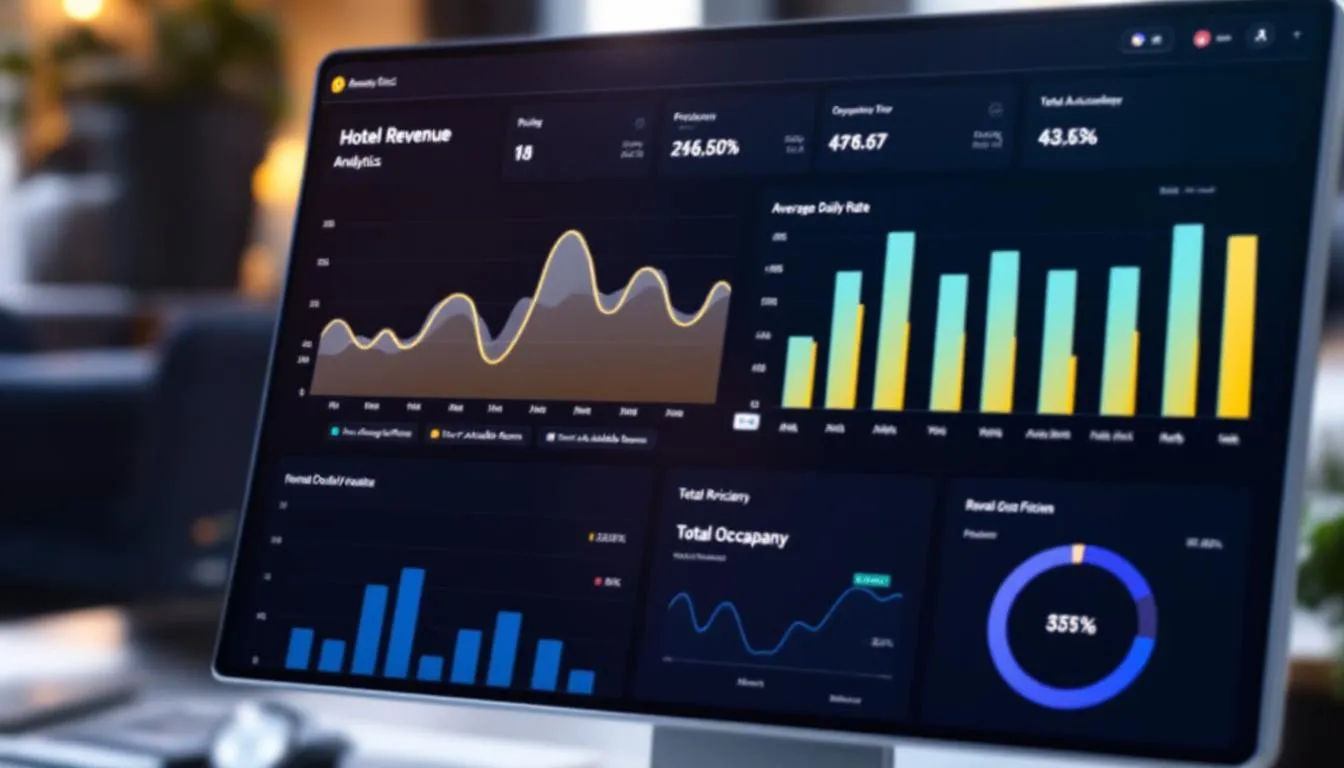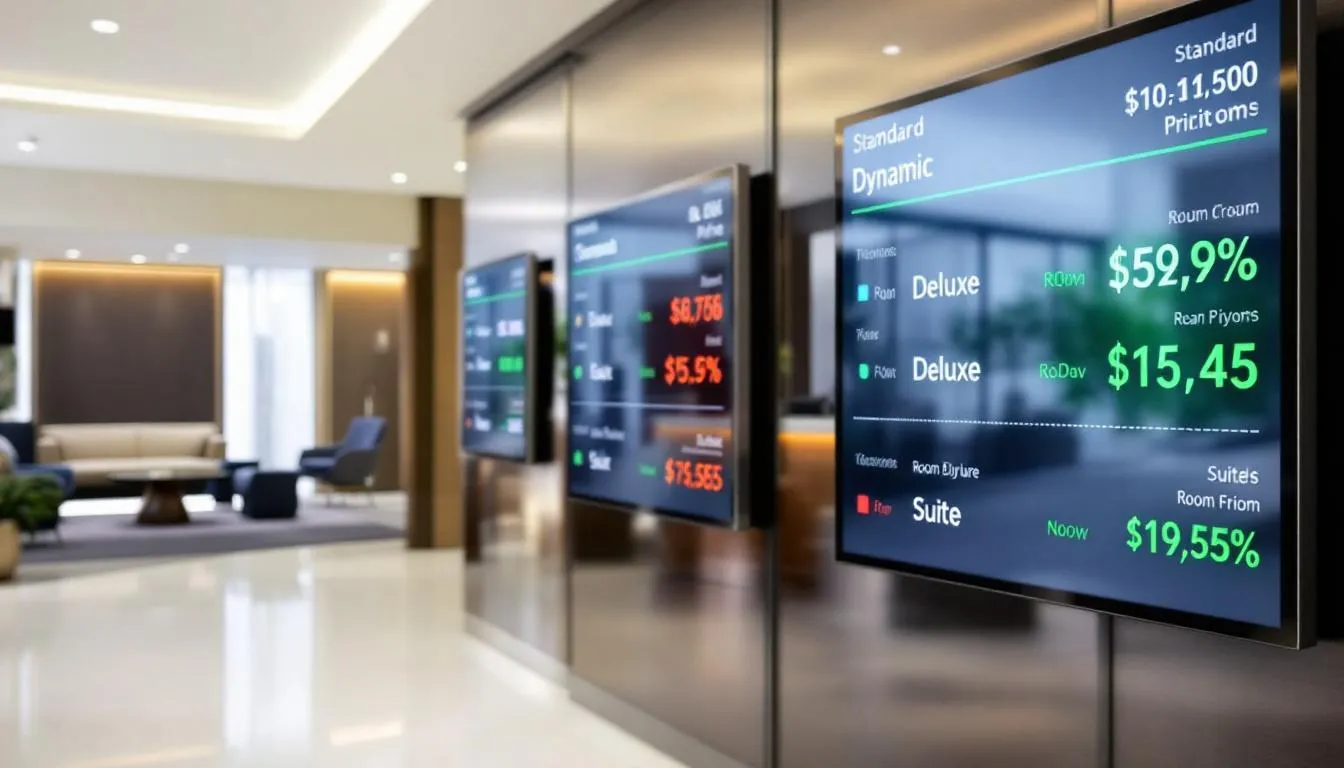Hotel Dynamic Pricing Software: 2025 Guide to Boosting Revenue
 Mika Takahashi
Mika Takahashi Mika Takahashi
Mika TakahashiIn today’s fast-paced hospitality world, sticking to static pricing is like leaving money on the table. Gone are the days when adjusting rates once a month was enough. Travelers now book through multiple channels, competitor prices change by the hour, and demand ebbs and flows with events, seasons, and countless other factors that no one can track manually.
That’s where hotel dynamic pricing software comes in—a smart solution that automatically updates your room rates in real-time, based on demand, competition, and market shifts. This guide will walk you through everything you need to know to leverage dynamic pricing and unlock your hotel’s full revenue potential.
Here’s what you’ll learn:
Hotel dynamic pricing software is a specialized tool designed to adjust your room prices automatically and frequently. It factors in changes in demand, occupancy, competitor pricing, booking speed, seasonality, special events, and other market signals. Unlike old-school manual pricing, this software uses smart algorithms to analyze heaps of data and push updates instantly across your booking channels—no human intervention needed.

Manual pricing methods come with a lot of drawbacks that can cost hotels big time:
Dynamic pricing software solves these problems by:
Modern hotel dynamic pricing software combines several key parts:
Algorithms and Pricing Rules: These smart models turn demand signals into price decisions, all within your set limits like minimum and maximum prices, competitor-match caps, and special segment rules.
Data Analytics Engine: Constantly pulls in data like occupancy rates, booking patterns, competitor prices, event calendars, seasonality, and customer behavior.
Automated Rate Adjustments: Automatically tweaks prices when certain triggers happen—say, occupancy hits 80%, and rates go up 10%.
Integration Capabilities: Connects smoothly with your property management system, channel manager, and direct booking engines so everything works together seamlessly.
Understanding the nuts and bolts of dynamic pricing helps explain why it outperforms manual methods. It’s all about collecting tons of data, analyzing it smartly, and making fast, automated pricing decisions around the clock.
The backbone of dynamic pricing is comprehensive data gathering from many sources:
Competitor Intelligence: The software keeps an eye on competitor rates, either by scraping data or receiving feeds from rate-shopping services. This helps you stay competitive without getting into damaging price wars.
Booking Patterns and Pace: Tracks how quickly bookings fill up for future dates, occupancy by date and customer segment, booking windows, and cancellations. These clues reveal demand trends for each arrival date.
Market Demand Factors: Integrates info from event calendars, weather forecasts, flight data, and local market conditions to anticipate demand shifts.
Customer Behavior Indicators: When available, analyzes search activity, length of stay, and guest preferences to fine-tune pricing.
Today’s dynamic pricing tools use AI and machine learning to forecast demand and optimize revenue. They analyze past data, current trends, and booking pace to suggest or automatically apply price changes that maximize revenue while respecting your pricing boundaries.
The system balances price with expected booking likelihood to hit the best Average Daily Rate (ADR) and Revenue per Available Room (RevPAR). As the check-in date nears, the algorithms get more precise, reacting quickly to booking surges or slowdowns.
Here are some real-world examples:
After computing new prices, the software updates rates everywhere—OTAs, direct booking engines, Global Distribution Systems (GDS), and central reservation systems. This keeps rates consistent and calendars synced without any manual work.
Thanks to cloud-based PMS integrations with open APIs, inventory and pricing updates happen instantly at the room-type and date level, making your tech stack work seamlessly.
Dynamic pricing software often forecasts demand and suggests prices up to a year in advance. It blends long-term baselines—factoring in seasonality and known events—with short-term responsiveness to booking spikes and competitor moves.
As arrival dates get closer, update frequency increases, sometimes multiple times per day during busy periods or sudden market changes.
Adopting hotel dynamic pricing software can transform your revenue and operations in several ways:
Hotels using dynamic pricing often see a 5-15% boost in ADR and RevPAR. The software raises rates when demand peaks, capturing guests’ willingness to pay more, and lowers them strategically during slower periods to fill rooms profitably.
This smarter pricing smooths out occupancy swings—avoiding missed revenue during busy times and empty rooms during off-peak periods.
Automation takes the drudgery out of manual rate shopping and updates. Revenue managers can spend more time on strategy instead of repetitive tasks. Once rules are set, rate changes happen automatically.
Teams report saving 10-15 hours per week, freeing up time for deeper market analysis and revenue growth initiatives.
Quick reactions to competitor moves and demand shifts mean you never miss a chance to optimize pricing. When a competitor changes rates or an unexpected event drives demand, your system adjusts within minutes—not days.
This agility prevents revenue loss caused by slow manual updates.
During slow periods, the software lowers rates and uses tactics like length-of-stay restrictions to stimulate bookings. This leads to higher utilization compared to static pricing.
Pricing guardrails prevent rates from going too high or low, protecting your brand image. The software enforces pricing rules consistently across all channels, eliminating human errors and ensuring rate parity.
Machine learning enhances demand forecasts, helping you apply yield management strategies like overbooking and promotions more effectively. Better predictions support smarter capacity planning.

The market offers solutions tailored to different hotel sizes, budgets, and operational needs. Here’s a quick overview to help you find your perfect fit.
IDeaS Revenue Solutions: A leader in enterprise hotel revenue management, IDeaS offers advanced forecasting and price optimization for complex portfolios. It integrates deeply with PMS and reservation systems, handling multi-property and corporate rates with AI-driven automation.
Atomize: This AI-powered RMS focuses on forward-looking data and continuous price optimization. Ideal for hotel chains managing multiple properties with sophisticated automation needs.
RevControl: Offers comprehensive revenue management with competitor intelligence and dynamic pricing recommendations for professional revenue teams who want detailed analytics and flexible controls.
Beonprice: AI and machine learning-based system providing detailed pricing insights aimed at mid-sized hotels, combining robust analytics with user-friendly interfaces.
AIOSell: Cloud-based platform bundling revenue management, CRM, and booking engine integrations. Suits mid-market hotels seeking an all-in-one tech stack with advanced pricing features.
Happyhotel: Designed for small to medium hotels, offering automated pricing and yield management at around $5 per room monthly, focusing on simplicity.
Room Price Genie: Tailored for independents, automates up to a dozen daily rate adjustments. Subscription tiers typically range $109-$179 per month.
Pricepoint: Fully automated dynamic pricing focusing on channels like Booking.com and Airbnb. Priced around $6 per room monthly, great for small properties wanting hands-off optimization.
Hotelogix: Cloud PMS with integrated dynamic pricing. Pricing ranges $3.99-$8.99 per room monthly. Ideal for budget-conscious small hotels wanting bundled PMS and pricing.
Little Hotelier Insights: Real-time competitor rate analysis and market insights built for small properties. Complements Little Hotelier’s PMS and channel manager with straightforward rate intelligence.
| Solution | Target Market | Key Strength | Pricing Range |
|---|---|---|---|
| IDeaS | Enterprise | Advanced forecasting | Enterprise pricing |
| Atomize | Large chains | AI automation | Custom quotes |
| Room Price Genie | Independent | Ease of use | $109-179/month |
| Pricepoint | Small properties | Low cost | ~$6/room/month |
| Hotelogix | Budget hotels | Integrated PMS | $3.99-8.99/room |
When shopping for hotel dynamic pricing software, look for these capabilities that directly impact your revenue and efficiency:
Choose software that continuously monitors competitor rates and market signals, updating multiple times daily. Transparent rate shopping and alerts for significant market changes are a plus.
Your tool should let you set minimum and maximum prices, floor and ceiling rates by room type, date, and segment. Support for length-of-stay restrictions and advance purchase rules is essential. Adjustments should be quick and easy—just a few clicks.
Look for direct integrations with OTAs and booking engines to instantly update rates and maintain parity. Cloud-based systems often offer better integration than legacy solutions.
The software should forecast demand up to a year ahead, learn from booking patterns, and support scenario testing. Clear explanations of predictions help you trust automated recommendations.
An intuitive interface that visualizes demand trends, booking pace, and competitor positioning enables quick decisions. Mobile access lets you monitor and override pricing on the go.
Track ADR, RevPAR, occupancy, booking pace, and channel performance to evaluate your pricing strategy. Post-implementation analytics help refine your approach continuously.

Getting the most from dynamic pricing means careful planning and change management.
Start with a Pricing Audit
Review your current pricing strategy, customer segments, seasonality, and distribution channels. Set clear goals and KPIs like ADR, RevPAR, and occupancy targets. Decide how much automation you’re comfortable with.
Prepare Your Data
Clean your booking data, fix room type mappings, and gather competitor sets and event info. High-quality data is critical for accurate pricing.
Train Your Team
Explain pricing rules, guardrails, and override processes. Highlight how automation saves time and reduces errors to ease concerns.
Roll Out in Phases
Begin with recommendation mode before increasing automation. Test rules and monitor booking patterns to fine-tune settings.
Monitor Performance
Track key metrics before and after implementation. Analyze different market segments and events to spot areas for improvement.
Plan for Integration
Ensure your PMS supports APIs and integrates well with your pricing software. Cloud-based systems usually simplify this step.
Data Issues
Incomplete or inaccurate data hurts pricing accuracy. Implement regular audits and validation processes.
Staff Resistance
Address fears about losing pricing control by keeping override options and explaining automation benefits.
Legacy Systems
Older PMS may limit real-time updates. Consider middleware or upgrading to API-friendly platforms.
Balancing Automation and Oversight
Avoid over-automation by setting guardrails and alerts for unusual pricing. Keep manual overrides ready.
Guest Perceptions
Frequent price changes can upset guests. Be transparent and maintain rate parity to build trust.
Rate Parity Compliance
Monitor distribution channels to prevent parity violations and maintain OTA relationships.
Dynamic pricing often boosts ADR and RevPAR by 5-15%, capturing more revenue during peaks and improving occupancy off-peak.
Compare software and integration costs to additional revenue and time saved. Most hotels see ROI within 3-6 months.

Enterprise chains need advanced forecasting and multi-property management. Independent hotels benefit from simplicity, automation, and cost-effectiveness. Mid-market hotels fall in between.
Budget and Pricing Models
Look at per-room vs. flat subscription pricing, support, integrations, and training included. Make sure expected revenue gains justify costs.
Technical Compatibility
Check PMS API availability and integration with channel managers and booking engines.
Support and Onboarding
Good vendor support speeds up implementation and boosts team confidence.
Scalability
Choose software that grows with your business and supports new market segments and channels.
Take Advantage of Trials
Pilot programs or advisory-mode trials help evaluate forecasting accuracy and usability before committing.
Smarter AI and Machine Learning
Future systems will optimize pricing down to microsegments and individual room features, personalizing offers and packages.
Guest Sentiment Integration
Algorithms will factor in online reviews and social media sentiment to adjust pricing based on perceived value.
Personalized Pricing
Dynamic rates tailored to loyalty status and booking history will become standard, blending public pricing with targeted offers.
Real-Time External Data
More data sources like local business activity and social media event tracking will improve demand forecasting.
Mobile and Voice Controls
Hands-free monitoring and voice commands will make pricing management even easier.
Sustainability Considerations
Pricing may soon reflect operational costs and environmental impact, aligning revenue goals with eco-friendly practices.
Hotel dynamic pricing software is a game-changer, shifting you from reactive to proactive revenue management. It lets you capture the best rates while saving time and reducing errors. Hotels using it typically see 5-15% revenue boosts and free up staff to focus on strategy.
Choosing the right solution, planning carefully, and continuously optimizing will help you stay competitive and profitable in a complex market. Whether you run a single property or a large chain, dynamic pricing software can transform your pricing game.
The real question isn’t if you should adopt dynamic pricing, but which software fits your hotel best—and how soon you want to start capturing more revenue. Don’t wait—your competitors may already be ahead of you.